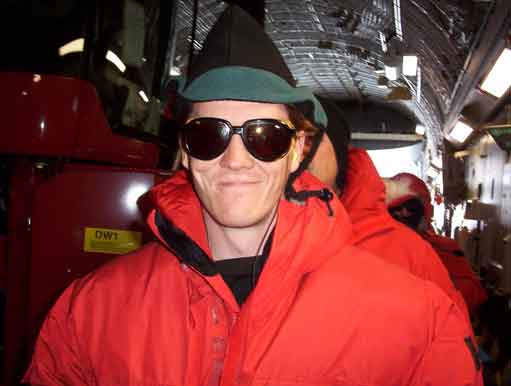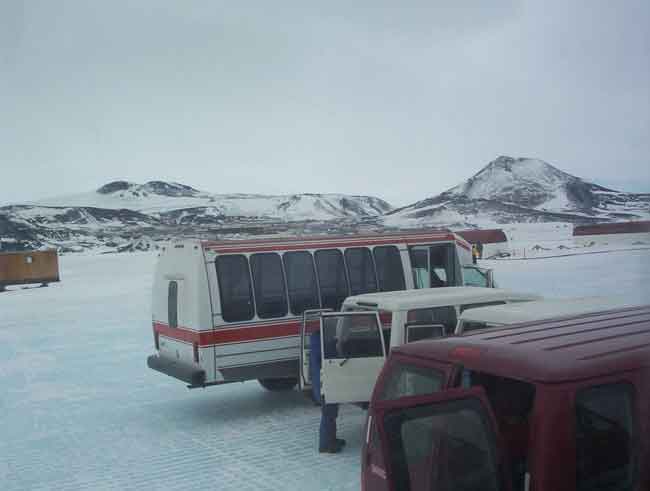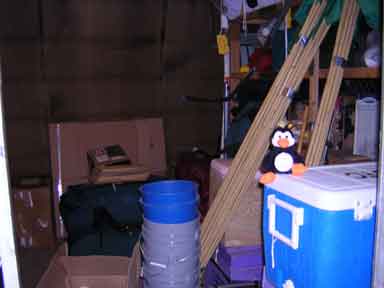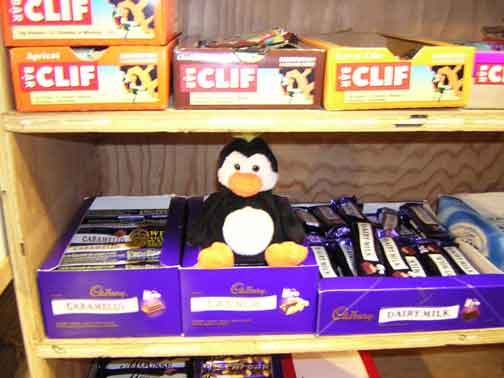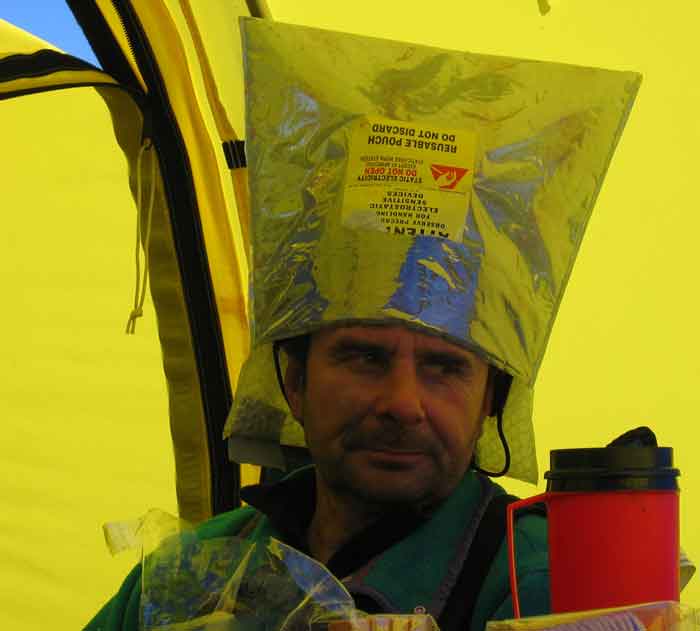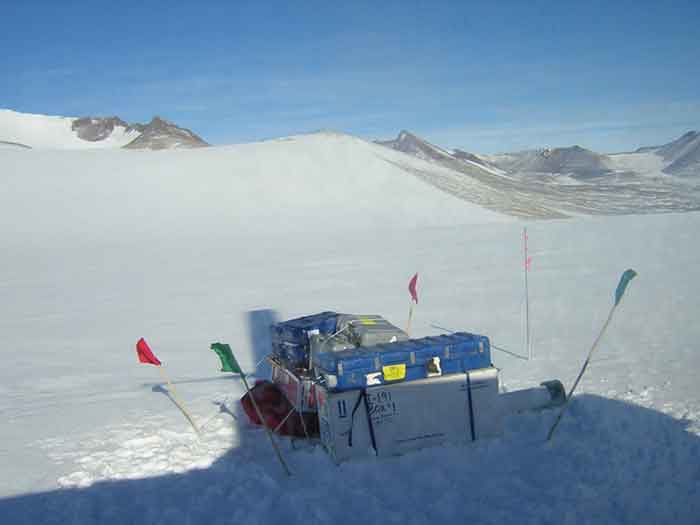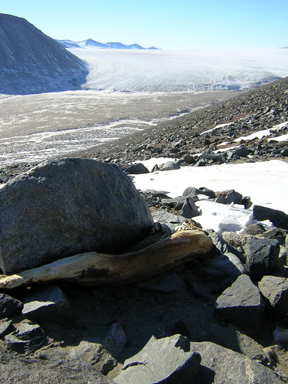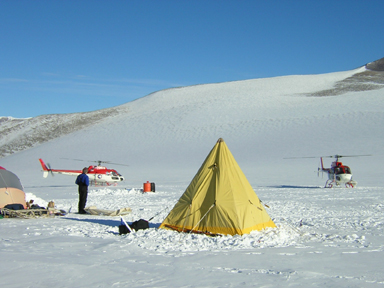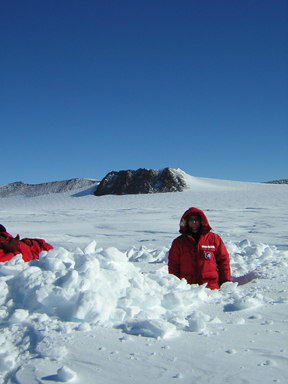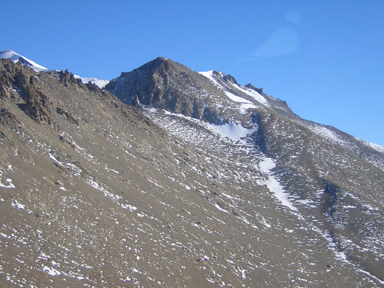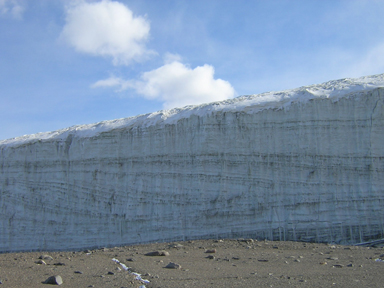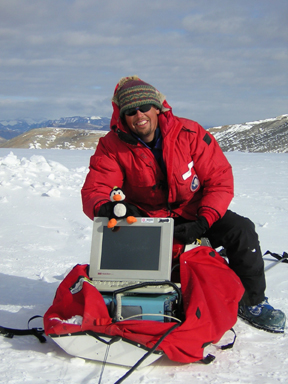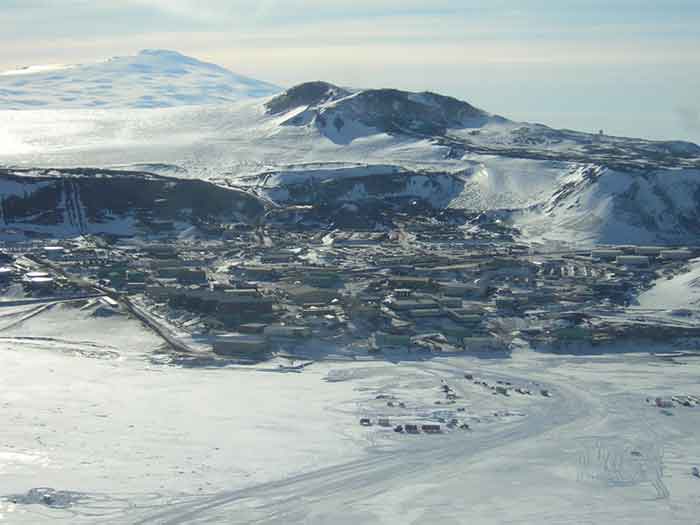
Ice Cores from the Dry Valleys of Antarctica
Ice Cores from the Dry Valleys of Antarctica 2005
Karl Kreutz, Bruce Williamson, Mike Waskiewicz, Terry Gacke and Toby Burdet
October 20, 2004 – December 15, 2005
The goals of this project are to collect and develop high-resolution ice core records from the Dry Valleys region of Antarctica, and provide interpretations of interannual to decadal-scale climate

variability during the last 2000 years (late Holocene). In particular, we seek to test hypotheses related to ocean/atmosphere teleconnections (e.g., El Niño Southern Oscillation, Antarctic Oscillation) that may be responsible for major late Holocene climate events such as the Little Ice Age in the Southern Hemisphere. We plan to collect intermediate-length ice cores (100-200m) at four sites along transects in Taylor Valley and Wright Valley.
October 20, 2005
Bruce writes from McMurdo:
The first six days of this season are best summed up with the question, “Where’s our luggage?” I flew from Bangor to Christchurch on October 10-12, but I came very close to missing my connection in Los Angeles; my bags did miss the connection. So I spent the first couple of days in New Zealand with minimal clothing (I bought enough to tide me over), and none of my gear.
Thankfully, I did have my camera on me, so I can introduce to you Macaroni, the penguin, who has joined us this year from Asa Adams school in Maine. Also joining Karl and me are Mike Waskiewicz and Terry Gacke, from last year, and a new crew member, Toby Burdet. This is Toby’s first trip to Antarctica, and he is enjoying himself going through the Happy Camper school (see the 2003 description of this class) and meeting new people here at McMurdo. Toby has a lot of experience in the mountains as a guide, so fortunately, he is not fazed by the cold -12° F (-42° with wind chill).
Fortunately, my bags arrived in Christchurch just before we got on to the plane to come down to “MacTown”, so I have clothing and personal gear again. Unfortunately, however, we arrived here to discover that all of the science gear that Karl and I packed in August to ship down here has not arrived. So we are now waiting for the equipment that will allow us to complete our research. The cargo handlers here are very good at finding and moving boxes, so we should have our instruments by early next week, but it’s an unfortunate delay.
In the meantime, Mike, Terry, Toby and I are gathering all of our camping equipment so that we will be comfortable during our season (as comfortable as possible, anyway), and getting it all packaged to head out. Macaroni particularly enjoyed the chocolate, though he found the whole process of gathering material for an Antarctic expedition enjoyable.
I will be in touch again before we take off and then again when we return. For now, it’s back to the room for some sleep.
October 25, 2005
Bruce writes from McMurdo:
Well, the gear has now all arrived (it arrived on the same plane that brought Karl), and we are all set to leave tomorrow. We have about 7000 pounds of food, camp gear and science gear — drill, protective equipment, etc. — with us this year. Karl has completed his refresher course in Antarctic survival, and today we collected frozen food, one of the last items “pulled”, given perishability.
I went out today to guide the helicopter pilots to the site, so that they know exactly where we want them to put our camp. The boxes for the drill weigh as much as 250 pounds, so if the pilot drops the gear more than a few meters from where we want to drill, it is not a small matter to move it. The site looks good after a year away. The snow is smooth, where last year it was very rough with sastrugi (wind forms). After I left, there were three more flights with just cargo, taking most of our gear and dropping it there. The last remaining bits will fly with us tomorrow.
During my flight, the valley walls and floors were stunning as ever. The infinite variety of shapes and patterns in the rocks of this area is truly remarkable.
Finally, Toby and I spent some time finalizing the packing of the sample bottles we will use in our sampling of snow pits, and now we are getting ourselves all packed up to leave in the morning. Tomorrow morning at 10:15 is our scheduled time. We are looking forward to a great season. I’ll send news when we return.
October 27, 2005
A great Sunday. We have now collected one short core about 20 m from the Clark and have begun drilling the second, which will be deeper. Today, however, we took a hike down into the Victoria Valley, which is one of my favorite places on the planet. On the way to the valley floor, we also came across a mummified seal (look carefully beneath the boulder in the photo); the odd thing is that this seal was at least 300 meters above the valley floor and several kilometers from the sea ice! This is our first mystery for the season. How did the seal get there? And how long has it been there?
Beyond the seal, the valley was as spectacular as I remember, and we had a great walk, examining all the ventifacts (sand/wind polished rocks) and the ripples in the valley sand. There really is no place on Earth to compare to this, though NASA uses these valleys to predict what Mars might be like. A wonderful place to explore!
It was also amusing to have one afternoon where the helicopter broke down after bringing us boxes for our ice core, so the picture of the two helicopters in camp is actually a picture of the one helicopter coming out to provide service for the other one. The pilot enjoyed a nice coffee break with us while he waited for this help to arrive.
The pit digging continues, only for the last couple of sites, Karl and I have gone to dig, as Toby has come down with a sinus infection. On Saturday, we went to the Newall Glacier, and today we went to the Meserve Glacier. These two glaciers are not locations where we are collecting cores, but by getting surface samples, we will be able to compare the chemistry in the snowpack at these sites to the chemistry at the locations where we have cores. This will allow us to tell how the chemistry we find in our cores relates to the chemistry of Dry Valleys snow and ice in general. As usual, the helicopter flights provide great opportunities for Dry Valleys scenery photos.
After a couple of days of not feeling great, Toby left this afternoon to go to McMurdo. We look forward to seeing him again soon! The camp is quite a bit smaller with only four.
November 09, 2005
Last night, our camp became very small indeed. Yesterday, Karl and Mike went to the Commonwealth Glacier to break down the poles and the weather station we set up there last season and to dig yet another snowpit. Because of the weather station and the poles and the fact that the snowpit at the Commonwealth was a two-meter pit rather than the one-meter pits at the Newall and the Meserve, Karl and Mike stayed overnight (intentionally) on the Commonwealth to get their work done. With Toby still in town getting healthy, that meant that yesterday and last night, only Terry and I remained on the Clark. As the numbers in camp decline, this site feels more and more remote!
We enjoyed double portions of halibut for dinner, however, and this made our situation quite comfortable. We were worried for a bit that Karl and Mike would not be able to get back, as the weather didn’t look great, but that did not happen, as they arrived midday today. We are now back to four. While they were gone, Terry and I moved the drill and started our third core on the Clark; we now have more than 40 meters of core from this hole in the first two days of drilling. Our drilling is getting more and more successful with each day at this location.
November 11, 2005
Toby returned yesterday, and he and Karl immediately left on the same helicopter that brought him to the Clark to go and dig our last remote snowpit at the Rhone Glacier. Apparently, the Rhone was a very cold place to spend a day, so it was quite a welcome back for Toby! But he is healthy, and it is good to have our camp back to full capacity. And he brought goodies and movies from town. Life is good!
For the past few days, we have had sled dog work to do. But we have no dogs. So Toby and I have been harnessed to a sled which contains ground penetrating radar walking up and down the Clark Glacier testing the equipment. We use the radar to find the bedrock under the ice and by doing this find out how thick the ice is where we are drilling. This helps us to know how much time is captured in the ice we are drilling. Actually, we brought the radar mostly to test the depth on the Victoria Upper Glacier, as we already did a radar survey on the Clark in 2003, but it is good to have the extra data for the Clark as well, and now we know that the radar works and that we know how to run it. It’s also good having Toby back, and we have once again settled into our earlier routines, with the exception that now we are also hosting one of the “artists in residence” for the United States Antarctic Program, bringing our camp to 6 members. The artist’s name is Sara Andrews, and she writes mystery novels based on geology themes. We have tried to convince her to try to solve the mystery of the seal, but I don’t think she is going that direction. She helped Toby and me with the radar, which was much appreciated, and has also made some great food. Sara will be with us for the next week or so, depending on helicopter availability and other factors. Drilling continues to move forward, and we are getting better core at this depth (about 150 meters) than we have been able to get before.
We also took an evening and went down to the toe of the glacier to see what the Wright Valley and the glacier cliff were like. To see the ice we have been on top of from the side is a powerful experience. We also heard pieces calving off of this face quite a bit. A good thing we weren’t under them.
November 19, 2005
Wow. The Victoria Upper Glacier is truly an extraordinary site. The scenery is incredible, with hills and cliffs which remind me of the southwest (Arizona, New Mexico), but surrounded by ice. And the views are almost as good in any direction you look. Yesterday we moved camp to get here, which is always exciting, with several helicopters helping move us all of our science and camp gear from one site to another. It’s a very busy day, and we were all tired by the end of it. A new round of steaks solved that problem, however, and we slept well last night.
Today I planted the flags which will be the “roads” used for our radar survey here. This consists of 15 flags laid out with 100 meters between each forming a line going from uphill to downhill on the glacier, and three lines of 600 meters running perpendicular to this main line surrounding the drill site. The surface on this glacier is not nearly as friendly as that on the Clark! The sastrugi are not as big as those from last year, but they are sizable, and dragging the sled with the radar system over them is not going to be easy. There is also more of a slope here, so we will be going uphill. We have some hard work ahead… The drill is set up and we have already begun to get some core. A quick start; this is good, given that we plan to be here for only a little over a week.



